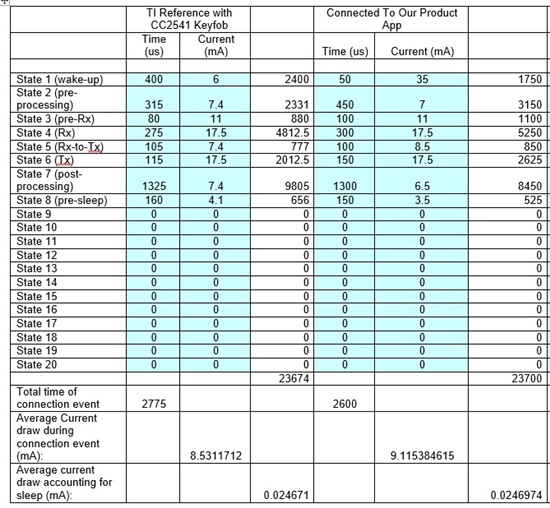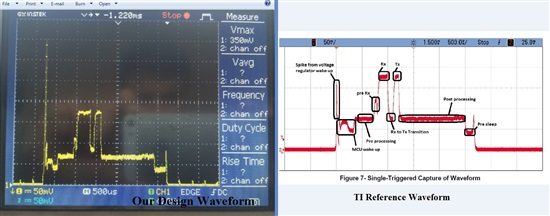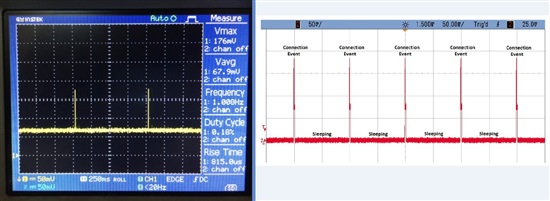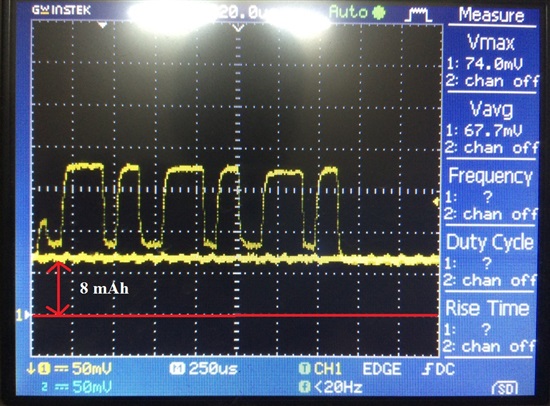Hi All,
We are developing a project based on TI's CC2541 Keyfob reference design, that communicates with the App on iOS/Android devices.
We are facing with excess power consumption problem during advertising state.
We referred some of the links available on the TI forum regarding the same issue and made necessary changes to our code, but still its consuming more power.
We have compared the current consumption of our device in connected state with the one mentioned in the TI's Keyfob Application Note and the average current consumption was almost equal but in advertising state its consuming more power.
I am attaching the power consumption comparison chart for Keyfob and our device in connected state.
Image 1: power consumption comparison chart for Keyfob and our device in connected state
I am also attaching the waveforms obtained while testing for our device along with the TI's reference waveform.
Connected State
Image 2: Wave forms obtained in Connected State for our Device 'vs' Keyfob reference design
The obtained wave form looks similar to the TI's reference wave form if it was in connected state with our App.
Advertising State
In advertising State, its different from the Reference design, it consumes nearly 8mAh power while advertising and consumes even more during connection event.
Image 3: Wave forms obtained in Advertising State for our Device 'vs' Keyfob reference design
Image 4: Wave form showing default power consumption in Advertising State for our Device
This image clearly shows that by default it consumes 8mAh during advertising and consumes even more power during connection intervals. Hence, our device consumes more power in advertising mode that reduces the battery life.
Kindly, check the above details and suggest us the required solution to reduce the power consumption during Advertising state.
Additional details for your reference
We are using CR1632 (3V, 140mAmp) coin cell for our device
Connection Parameters for our device are as follows
// Use limited discoverable mode to advertise for 30.72s, and then stop, or
// use general discoverable mode to advertise indefinitely
//#define DEFAULT_DISCOVERABLE_MODE GAP_ADTYPE_FLAGS_LIMITED
#define DEFAULT_DISCOVERABLE_MODE GAP_ADTYPE_FLAGS_GENERAL
// Minimum connection interval (units of 1.25ms, 80=100ms) if automatic parameter update request is enabled
#define DEFAULT_DESIRED_MIN_CONN_INTERVAL 80
// Maximum connection interval (units of 1.25ms, 800=1000ms) if automatic parameter update request is enabled
#define DEFAULT_DESIRED_MAX_CONN_INTERVAL 800
// Slave latency to use if automatic parameter update request is enabled
#define DEFAULT_DESIRED_SLAVE_LATENCY 0
// Supervision timeout value (units of 10ms, 1000=10s) if automatic parameter update request is enabled
#define DEFAULT_DESIRED_CONN_TIMEOUT 500
// Whether to enable automatic parameter update request when a connection is formed
#define DEFAULT_ENABLE_UPDATE_REQUEST TRUE
// By setting this to zero, the device will go into the waiting state after
// being discoverable for 30.72 second, and will not being advertising again
// until the enabler is set back to TRUE
uint16 gapRole_AdvertOffTime = 0;
uint8 enable_update_request = DEFAULT_ENABLE_UPDATE_REQUEST;
uint16 desired_min_interval = DEFAULT_DESIRED_MIN_CONN_INTERVAL;
uint16 desired_max_interval = DEFAULT_DESIRED_MAX_CONN_INTERVAL;
uint16 desired_slave_latency = DEFAULT_DESIRED_SLAVE_LATENCY;
uint16 desired_conn_timeout = DEFAULT_DESIRED_CONN_TIMEOUT;
// Set the GAP Role Parameters
GAPRole_SetParameter( GAPROLE_ADVERT_ENABLED, sizeof( uint8 ), &initial_advertising_enable );
GAPRole_SetParameter( GAPROLE_ADVERT_OFF_TIME, sizeof( uint16 ), &gapRole_AdvertOffTime );
GAPRole_SetParameter( GAPROLE_SCAN_RSP_DATA, sizeof ( deviceName ), deviceName );
GAPRole_SetParameter( GAPROLE_ADVERT_DATA, sizeof( advertData ), advertData );
GAPRole_SetParameter( GAPROLE_PARAM_UPDATE_ENABLE, sizeof( uint8 ), &enable_update_request );
GAPRole_SetParameter( GAPROLE_MIN_CONN_INTERVAL, sizeof( uint16 ), &desired_min_interval );
GAPRole_SetParameter( GAPROLE_MAX_CONN_INTERVAL, sizeof( uint16 ), &desired_max_interval );
GAPRole_SetParameter( GAPROLE_SLAVE_LATENCY, sizeof( uint16 ), &desired_slave_latency );
GAPRole_SetParameter( GAPROLE_TIMEOUT_MULTIPLIER, sizeof( uint16 ), &desired_conn_timeout );
GAP_SetParamValue(TGAP_GEN_DISC_ADV_INT_MIN , 1600);
GAP_SetParamValue(TGAP_GEN_DISC_ADV_INT_MAX , 1600);
/****************************************************************************************************************/





